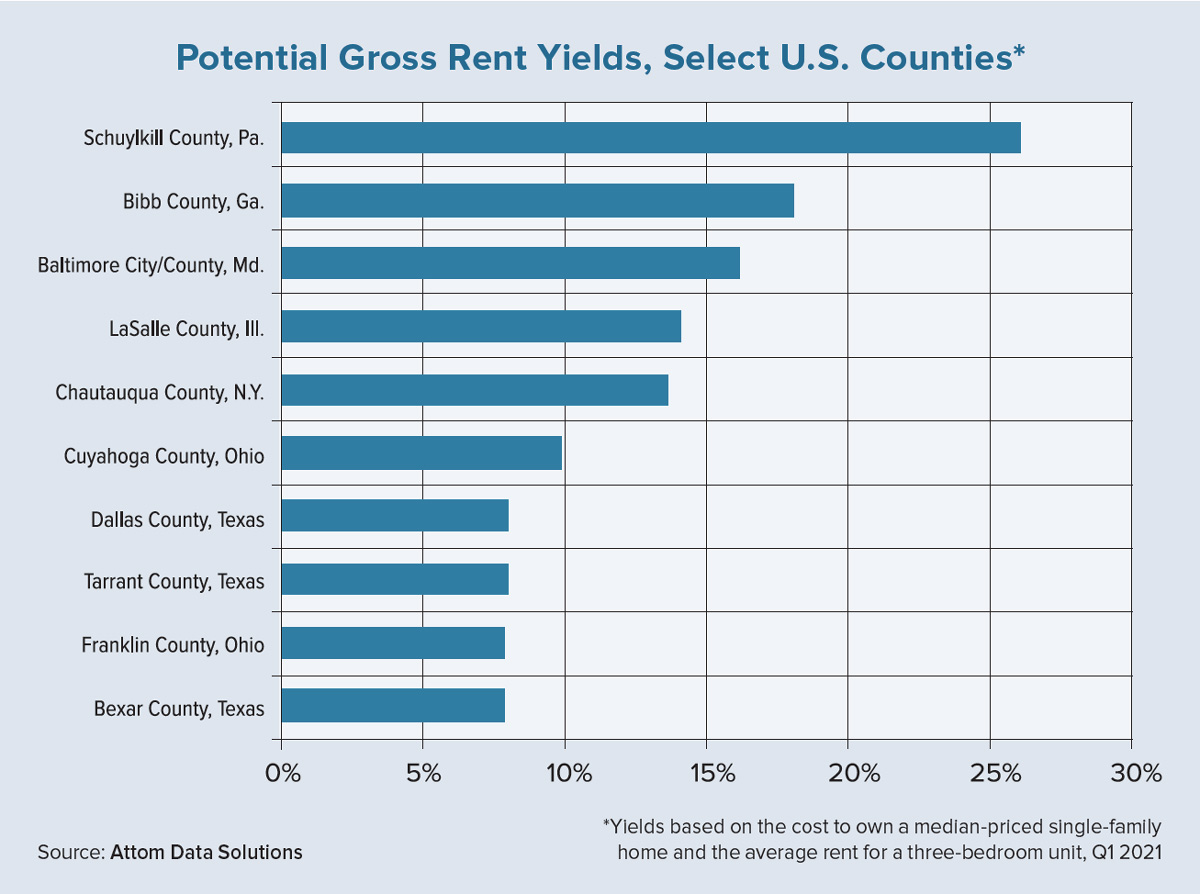Mortgage originators who help to
finance homes in the singlefamily
rental (SFR) space should
know that investor yields for
these properties are slipping as U.S. home
prices continue to increase, according to a
first-quarter 2021 report from Attom Data Solutions.
This report ranks the top markets across
the country for purchasing single-family
rental properties by analyzing 495 counties,
all with populations of at least 100,000 as well
as sufficient rent- and home-price data.
Among these counties, the average annual
gross rental yield in Q1 2021 was 7.7%, down
year over year by 70 basis points. Rent yields
declined over this 12-month span in 87% of the
counties studied, led by declines of 20% or more
in many locations. These include Baltimore
City/County, Maryland (down 43.9%); St.
Louis City/County and St. Louis County,
Missouri (down 35.5% and 29.3%, respectively);
Bonneville County, Idaho (down 26.7%); and
Fairfield County, Connecticut (down 24%).
The largest metropolitan areas fared a bit better, but many saw SFR
yields decline by more than 10%. Among counties with a population of
at least 1 million, the largest annual decreases occurred in Miami-Dade
County, Florida (down 19.9%); Oakland County, Michigan (down 18.6%);
King County, Washington (down 17.4%); Palm Beach County, Florida
(down 14.2%); and Fulton County, Georgia (down 13.3%).
These declines may be attributable to several factors, but chief among
them are the continued home-price increases seen across the country.
It can be complicated for rental-property investors to balance rising
home prices with appropriate rents, especially since they also must keep
on eye on whether wages are rising or falling in their local markets.
In a whopping 87% of the 495 counties analyzed, sales prices for singlefamily
homes increased at a faster pace than rents. This is particularly
true in the most-populous metro areas, including the California
counties of Los Angeles and San Diego; Cook County (Chicago), Illinois;
Harris County (Houston), Texas; and Maricopa County (Phoenix),
Arizona. These price increases could start making homeownership
less affordable in some areas, putting upward pressure on rents and
potentially leading to higher rent yields.
On the other hand, only 13% of the counties studied showed rents
rising faster than single-family home prices. Among these are the
Bay Area counties of San Francisco and San Mateo, locations long
known for their high costs of living, whether this involves buying a
home or renting one.
Other locales where rents grew faster than home prices include
Jacksonville’s Duval County, the Houston suburb of Fort Bend County
and the Chicago suburb of Kane County. It’s interesting to note the
dichotomy in the Houston and Chicago metro areas as each include
counties where both patterns are occurring.
Despite the declining yields over the past year, overall returns on SFR
homes remain strong. If home prices continue to increase faster than
rents, this will push demand for rental properties and could lead to
higher yields. There are some areas where SFRs are thriving and yields
exceeded 10%.
The five counties with the highest potential annual gross rental yields
as of Q1 2021 are Schuykill County, Pennsylvania (26.1%); Bibb County,
Georgia (18.1%); Baltimore City/County (16.2%); LaSalle County, Illinois
(14.1%); and Chautauqua County, New York (13.7%). Among the top 50
counties for potential rent returns, the Midwest leads all regions with 25
counties represented, followed by 15 in the South and 10 in the Northeast.
Attom Data identified a total of 61 counties with potential for singlefamily
rental growth. In these counties, average wages increased over
the past year and the potential 2021 annual gross rental yields are 10%
or more. These include Milwaukee County, Wisconsin; Shelby County,
Tennessee; Monroe County, New York; and Jefferson County, Alabama.
Although there are certainly some worrying signs, the SFR sector
continues to be a strong one that includes reasons for optimism.
Knowing which areas are responding best to the fluctuating market
conditions will help investors capitalize on opportunities as they arise. ●
Author
-

Todd Teta is chief product and technology officer at Attom Data Solutions, where he leads the company’s technology and product teams. Prior to joining Attom Data Solutions, Teta led the product-development and technology organization at Meyers Research. Teta also previously co-founded several startups, including VisionCore, a company serving the mortgage and real estate data and analytics markets that was later sold to CoreLogic. He is a graduate of the University of Southern California, where he earned a degree in computer engineering and computer science. Learn more about Attom Data Solutions at attomdata.com.
View all posts






